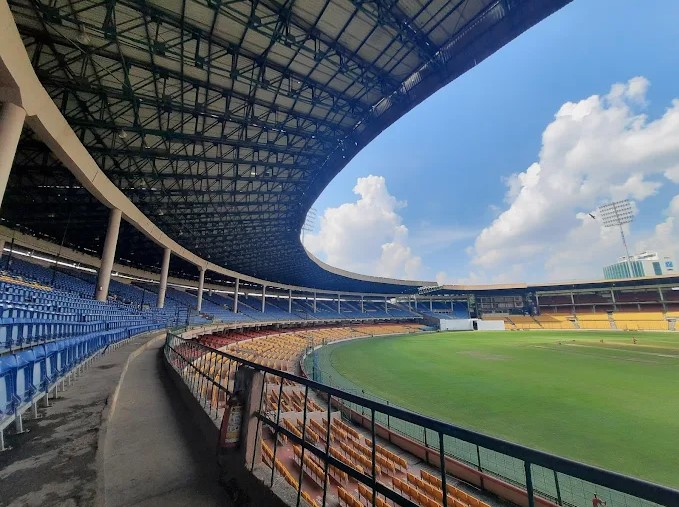M. Chinnaswamy Stadium, located in the heart of Bengaluru, Karnataka, is one of India’s most iconic cricket venues. Known for its electrifying atmosphere, batting-friendly pitch, and centrally located position, it has hosted countless memorable domestic and international matches. One factor that draws particular attention from players and fans alike is the stadium’s boundary length, which plays a crucial role in the nature of gameplay here.
Table of Contents
In this article, we’ll delve into the boundary dimensions of Chinnaswamy Stadium, how they influence match outcomes, and how they compare with other major cricket stadiums in India and around the world.
Overview of M. Chinnaswamy Stadium
| Feature | Detail |
|---|---|
| Location | Bengaluru, Karnataka |
| Established | 1969 |
| Capacity | Approx. 40,000 |
| Home Team | Karnataka (domestic), RCB (IPL) |
| Pitch Type | Batting-friendly |
| Elevation | Approx. 930 meters above sea level |
Boundary Dimensions of Chinnaswamy Stadium
Unlike rectangular football fields, cricket grounds vary in boundary dimensions due to their oval or circular shapes. At Chinnaswamy, boundaries are shorter than average, which has a significant impact on scoring patterns.
| Boundary Direction | Approximate Distance (in meters) |
|---|---|
| Straight | 65–70 |
| Square | 58–65 |
| Fine Leg | 55–60 |
| Third Man | 55–60 |
| Long-On/Long-Off | 65–70 |
| Midwicket | 60–65 |
Note: These values can vary slightly depending on the pitch location and playing conditions.
Why Are the Boundaries So Short?
There are several factors that contribute to the relatively short boundaries at Chinnaswamy:
- Urban Location: Being in the center of Bengaluru, expansion is limited. The compact land area means boundaries cannot be pushed further out.
- Spectator Proximity: The stadium was designed to keep fans closer to the action, enhancing the viewing experience.
- Architectural Constraints: Older design and redevelopment limitations prevent significant boundary expansion.
Impact on Match Outcomes
Short boundaries have a pronounced effect on how matches unfold at Chinnaswamy:
High Scoring Matches
The stadium has consistently produced high-scoring games, particularly in T20 formats like the Indian Premier League (IPL).
| Match Type | Average 1st Innings Score |
|---|---|
| T20 (IPL) | 170–190 |
| ODIs | 270–300 |
| Tests | 350–400 |
More Sixes
| Metric | Average per T20 Match |
|---|---|
| Sixes Hit | 14–18 |
| Fours Hit | 25–35 |
| Balls per Boundary | 4.5–5.5 |
Strategic Implications
For Batsmen:
- Encourages aggressive play and innovation.
- Even mis-timed shots can carry over short boundaries.
- Ideal for power-hitters and switch-hitters.
For Bowlers:
- Puts pressure on bowlers to vary pace and length.
- Spinners often suffer, but skilled ones who use flight and deception can succeed.
- Death over bowling becomes critical due to ease of hitting boundaries.
For Captains:
- Defensive fields are harder to set.
- Bowling rotations and field placements require constant adjustment.
- Winning the toss and batting first can be a strategic advantage in T20s.
Comparison with Other Indian Stadiums
| Stadium | Avg. Boundary Length | Characteristic |
|---|---|---|
| Eden Gardens, Kolkata | 70–75 meters | Balanced |
| Wankhede Stadium, Mumbai | 65–70 meters | Batting friendly |
| Narendra Modi Stadium, Ahmedabad | 75–80 meters | Larger ground |
| M. A. Chidambaram, Chennai | 68–73 meters | Spin-friendly |
| M. Chinnaswamy, Bengaluru | 58–70 meters | Shortest boundaries |
Famous Moments Due to Short Boundaries
- Chris Gayle’s 175 (RCB vs PWI, 2013):* Widely regarded as the greatest T20 innings, powered by 17 sixes, many of which just cleared the ropes.
- AB de Villiers’ rampage in 2015 and 2016: His ability to target all areas of the field turned the short boundaries into a nightmare for bowlers.
- Numerous high-scoring thrillers: Matches regularly cross the 200-run mark due to boundary-friendly conditions.
The short boundaries at M. Chinnaswamy Stadium are a defining feature that makes it one of the most entertaining cricket grounds in the world. For fans, it’s a place where sixes rain and records tumble. For cricketers, it’s a test of adaptability—bowlers must be creative, and batsmen must capitalize.
While some critics argue it gives an unfair advantage to batsmen, others celebrate it as a venue that brings cricket closer to spectators and guarantees excitement. Either way, Chinnaswamy’s boundary lengths continue to shape some of the most thrilling moments in modern cricket.


